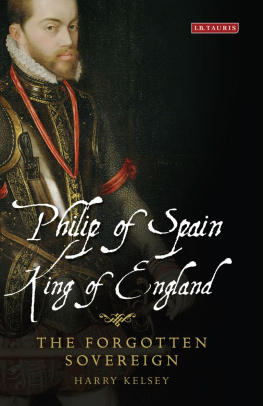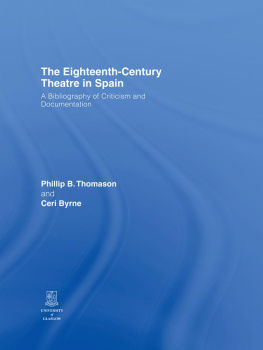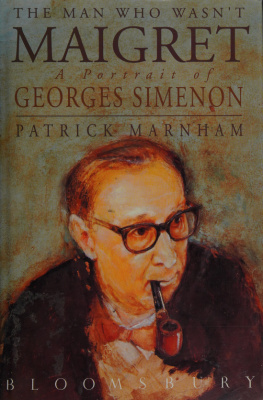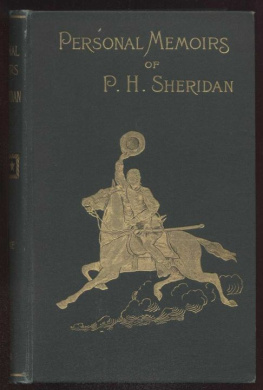Kamen Henry - Philip II of Spain
Here you can read online Kamen Henry - Philip II of Spain full text of the book (entire story) in english for free. Download pdf and epub, get meaning, cover and reviews about this ebook. City: New Haven;Conn, year: 1997, publisher: Yale University Press, genre: Non-fiction. Description of the work, (preface) as well as reviews are available. Best literature library LitArk.com created for fans of good reading and offers a wide selection of genres:
Romance novel
Science fiction
Adventure
Detective
Science
History
Home and family
Prose
Art
Politics
Computer
Non-fiction
Religion
Business
Children
Humor
Choose a favorite category and find really read worthwhile books. Enjoy immersion in the world of imagination, feel the emotions of the characters or learn something new for yourself, make an fascinating discovery.

- Book:Philip II of Spain
- Author:
- Publisher:Yale University Press
- Genre:
- Year:1997
- City:New Haven;Conn
- Rating:3 / 5
- Favourites:Add to favourites
- Your mark:
- 60
- 1
- 2
- 3
- 4
- 5
Philip II of Spain: summary, description and annotation
We offer to read an annotation, description, summary or preface (depends on what the author of the book "Philip II of Spain" wrote himself). If you haven't found the necessary information about the book — write in the comments, we will try to find it.
Philip II of Spain — read online for free the complete book (whole text) full work
Below is the text of the book, divided by pages. System saving the place of the last page read, allows you to conveniently read the book "Philip II of Spain" online for free, without having to search again every time where you left off. Put a bookmark, and you can go to the page where you finished reading at any time.
Font size:
Interval:
Bookmark:
Praise for Henry Kamen's
P h i l i p
O F S P A I N
formidably learned, impartial and just: a worthy achievement
Economist
a valuable contribution The arguments he puts forward will provoke reflection and debate
J.H. Elliott, New York Review of Books
his book supersedes all [previous biographies] in respect of his presentation of Philip the man This excellent book is a fine achievement. Since it is well written, it can also be read for pleasure by the general reader
Hugh Thomas, New York Times Book Review
Henry Kamen is perhaps the most challenging of historians of early modern Spain [This book] has set a standard of scholarship that [will be] hard to match
I.A.A. Thompson, Times Literary Supplement
a remarkable achievement what a good read!
Peter Gwyn, Daily Telegraph
although scores of authors will write about Philip II, few will marshall such an impressive range of new material
Geoffrey Parker, The Times
masterly a work of marvellous scholarship Library Journal
a highly impressive work, sympathetic but not uncritical a subtle and highly intelligent portrait
John Adamson, Sunday Telegraph
Despite an abundance of specialised studies of his reign, there has been no full-length biography of Philip II. Henry Kamen's impeccable scholarship provides it. Raymond Carr, Spectator

I dont know if they think I'm made of iron or stone. The truth is, they need to see that I am mortal, like everyone else.
Philip II, 29 Nov. 1578, Biblioteca Zablburu, Madrid (142 f.9)
Copyright 1997 by Henry Kamen
First published in paperback 1998
All rights reserved. This book may not be reproduced in whole or in part, in any form (beyond that copying permitted by Sections 107 and 108 of the U.S. Copyright Law and except by reviewers for the public press) without written permission from the publishers.
Set in Palatino by Best-set Typesetter Ltd, Hong Kong Printed in Great Britain by the MPG Books Group
Library of Congress Cataloging-in-Publication Data
Kamen, Henry Arthur Francis.
Philip of Spain/Henry Kamen.
Includes bibliographical references and index.
ISBN 978-0-300-07081-1 (cl.: alk. paper)
ISBN 978-0-300-07800-8 (pb.)
1. Philip II, King of Spain. 15271598. 2. SpainHistoryPhilip II. 15561598. 3. SpainKings and rulersBiography. I. Title. DP178. K36 1997 946'.043'092dc 21
[B]
9652421
CIP
A catalogue record for this book is available from the British Library.
10 9 8 7 6 5 4
Philip of Spain
Contents
Illustrations and Maps

PLATES
1. Titian, portrait of Isabel of Portugal. Prado, Madrid
2. Titian, equestrian portrait of Charles V. Prado, Madrid
3. Pompeo Leoni, bust of Philip. Kunsthistorisches Museum, Vienna
4. A. Snchez Coello, portrait of Isabella of Valois. Kunsthistorisches Museum, Vienna
5. Antonis Mor, portrait of Anna of Austria. Kunsthistorisches Museum, Vienna
6. Sonfonisba Anguisciola, portrait of the Infanta Catalina Michaela. Glasgow Museums: the Stirling Maxwell Collection, Pollok House
7. A. Snchez Coello, portrait of Don Carlos. Kunsthistorisches Museum, Vienna
8. Letter from Philip to the duke of Savoy. British Library, London
9. Fabrizio Castello and Niccol Granello, The Battle of Saint Quentin, detail of a fresco in the Sala de las Batallas in the Escorial. Photo Mas
10. H. Letter, Battle of Lepanto, contemporary imaginary view. National Maritime Museum, London
11. Design for a tapestry of the Armada, sixteenth-century. National Maritime Museum, London
12. William Key, portrait of the duke of Alba, 1568. Collection of the Duke of Alba, Madrid. Photo Mas
13. Anonymous portrait of the princess of Eboli. Collection of the Marquess of Santillana, Madrid. Photo Mas
14. Antonis Mor, portrait of Anton Perrenot de Granvelle, 1549. Kunsthistorisches Museum, Vienna
15. Anonymous portrait of Antonio Prez. Escorial. Photo Mas
16. English school, The Milch Cow, c.1585. Rijksmuseum, Amsterdam
17. The execution of counts Egmont and Hornes in 1568, contemporary print.
18. Anonymous contemporary drawing of the building of the Escorial. Hatfield House, courtesy of The Marquess of Salisbury
19. After Juan de Herrera, View of the Escorial. Escorial. Photo Mas
20. Anton van den Wyngaerde, View of Valsan. National Library, Vienna
21. Contemporary print of Philip's palace in Lisbon.
22. A Spanish official with his scribe in Peru. From Guamn Poma de Ayala's Chronicle, 1615. Royal Library, Copenhagen
23. The silver mine at Potos, late sixteenth-century manuscript. Hispanic Society of America, New York
24. Men being paid to join the Indies fleet. Detail from a view of Cadiz from Civitates Orbis Terrarum.
25. Design by Jehan Lhermite for a gout-sufferer's chair for Philip, from Le Passetemps, 1595. Bibliothque Royale, Brussels. Photo Mas
26. Pantoja de la Cruz, portrait of Philip in his last years. Escorial. Photo Mas
MAPS
Preface
Philip II refused to let his life be written during his lifetime. He thereby saved himself from adulators, whom he hated. But he left the field wide open to detractors. Since then he has consistently been given a bad press. Denigrated in his own day by political foes abroad, by Protestants everywhere, and even within Spain by enemies such as his former secretary Antonio Prez, he acquired a sinister reputation that the passing of time only succeeded in blackening yet further.
The image presented by both his defenders and detractors has barely changed over four centuries. On the whole, biographies by his defenders have been appallingly bad. The scholarship of his enemies has by contrast usually been excellent. The splendid research done by modern Belgian, Dutch and English-speaking historians has completely altered our knowledge of aspects of his policies, but barely touched Philip's personal image. To historians he is an enigma, the most eminent historian of our time, Fernand Braudel, was obliged to conclude.
The American J. L. Motley penned in 1855 the classic portrait of Philip as the incarnation of evil: mediocrity, pedant, reserved, suspicious, his mind was incredibly small bigot, grossly licentious, cruel a consummate tyrant. Some Spanish contemporaries of Motley shared the same view. One of them affirmed (in 1889) that the figure of Philip has always been a sombre page in our history Suspicious, cruel, vengeful He committed authentic crimes with terrifying cold-bloodedness. In an influential Spanish study of 1948, notable for its attempt to be fair to Philip, Gregorio Maran could still portray him as suspicious, weak, indecisive and an accomplice in murder.
Through the centuries no historian dared to look closely into Philip the man. The only attempt at a purely biographical study was that by the Dane, Carl Bratli in 1912. Nearly all the multi-volume accounts (by Prescott, Merriman, and Forneron) are in reality political histories of the reign. The recent short life by Geoffrey Parker (1978) includes several personal details, but is also mainly a political survey and has significant differences of presentation from my own. Until now, in short, we have known very little about the thoughts, motives and preferences of the man who for half a century, during one of the most crucial epochs in history, governed the most extensive empire in the world.
Next pageFont size:
Interval:
Bookmark:
Similar books «Philip II of Spain»
Look at similar books to Philip II of Spain. We have selected literature similar in name and meaning in the hope of providing readers with more options to find new, interesting, not yet read works.
Discussion, reviews of the book Philip II of Spain and just readers' own opinions. Leave your comments, write what you think about the work, its meaning or the main characters. Specify what exactly you liked and what you didn't like, and why you think so.






